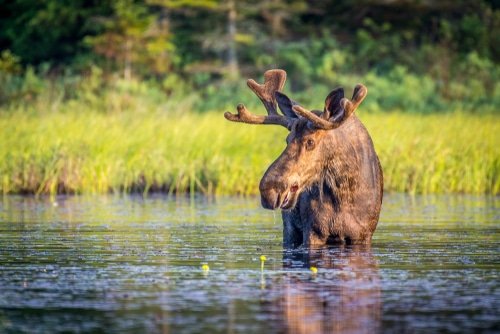When pondering the grand tapestry of creatures that roam this Earth, few can match the majestic presence of the moose. These gentle giants, with their towering antlers and mighty hooves, hold a prominent place in our collective imagination. However, beneath their awe-inspiring exterior lies a delicate balance of health and vulnerability that warrants our attention. In this blog we will review moose health and diseases.
To truly appreciate these magnificent beings, we must delve into the intricate realm of moose health. Understanding their well-being is not only an endeavor for animal enthusiasts but also a crucial aspect of responsible stewardship towards nature’s wonders.
An Overview of Common Diseases Affecting Moose
Alas! Even these magnificent creatures are not immune to the trials and tribulations inherent in nature’s design. In their journey through life, moose encounter various health issues that can threaten their existence.
From parasitic infestations to viral infections and bacterial diseases, there are multiple adversaries lurking in the shadows waiting to assail these gentle giants. As we embark upon this exploration into moose health, let us brace ourselves to uncover the secrets hidden within the realm of common moose diseases—those insidious ailments that pose a challenge to both wildlife conservationists and lovers of nature alike. —
Moose Anatomy and Physiology
Physical characteristics of moose
Moose, majestic creatures of the northern wilderness, possess a set of physical characteristics that make them truly remarkable. Firstly, their massive size commands attention – adult males, known as bulls, can reach heights up to 6.5 feet at the shoulder and tip the scales at an astonishing 1,500 pounds.
The females, or cows, are slightly smaller but still imposing in their own right. These ungulates boast long legs that help them navigate through various terrains and wade across shallow streams without difficulty.
Their broad muzzles contain strong upper lips that allow them to browse on vegetation with ease. Additionally, moose flaunt a dark brown coat adorned with thick fur that keeps them cozy during harsh winters.
Unique adaptations for survival in different habitats
Adaptability is one of nature’s most fascinating qualities, and moose exhibit a range of unique adaptations to thrive in diverse habitats throughout North America and Eurasia. In regions where snowfall is prevalent during winter months, these magnificent creatures have evolved to cope with the challenging environment by growing an impressive layer of insulating fat beneath their skin and an exceptionally dense coat consisting of hollow hairs that trap warm air close to their bodies.
This ingenious adaptation enables moose to withstand extreme cold temperatures without difficulty. Additionally, moose possess elongated legs which prove advantageous when traversing marshy areas or deep snowdrifts – their long limbs distribute body weight over a larger surface area, preventing sinking into soft terrain.
Remarkably powerful muscles enable these ungulates to swim effortlessly across lakes or rivers as they search for fresh vegetation on islands or farther shores. Understanding both the physical characteristics and unique adaptations of moose allows us to appreciate how these incredible animals have managed to thrive in such diverse environments.
By adapting to different habitats and evolving specific physical attributes, moose have demonstrated their resilience and ability to survive even under challenging conditions. In the following sections, we will delve deeper into the common diseases that can affect moose health and explore ways to prevent and manage these issues for the betterment of these magnificent creatures.

Factors Influencing Moose Health
Habitat Quality and Availability of Food Sources
One of the key factors affecting moose health is the quality of their habitat and the availability of food sources. Moose are herbivores and rely on a diverse range of vegetation for sustenance. A healthy habitat provides a variety of browse, such as young trees, shrubs, and aquatic plants, which are essential for meeting their nutritional requirements.
When the habitat becomes degraded or fragmented due to factors like deforestation or human encroachment, it can lead to limited food availability and poor nutrition for moose. This can weaken their immune system and make them more susceptible to diseases.
Climate and Weather Conditions
Another important factor that influences moose health is climate and weather conditions. Moose have adapted to survive in harsh northern climates, but extreme weather events can still pose challenges. Severe winters with heavy snowfall can restrict access to food sources and increase energy expenditure during foraging efforts.
This can lead to malnutrition and weakened immune systems in moose populations. On the other hand, unusually warm temperatures during summer can result in higher tick populations, increasing the risk of tick-borne diseases like Lyme disease.
Predators and Human Interactions
Predators play a significant role in shaping moose populations by preying on weaker individuals or regulating population densities. Predation by wolves, bears, or even humans (through hunting) helps maintain a healthy balance within ecosystems by removing sick or older individuals from the population.
However, excessive predation pressure can harm moose health if predator-prey relationships become imbalanced. Human interactions also have an impact on moose health.
Disturbances caused by habitat destruction and noise pollution from human activities like logging or recreational pursuits can cause stress to moose populations, leading to compromised immune systems and behavioral changes. Additionally, encroachment into moose habitats increases the risk of disease transmission between humans and moose, such as Brucellosis.
By understanding these factors that influence moose health, we can better appreciate their challenges in their natural environments. Implementing conservation measures to protect their habitats, managing predator populations responsibly, and promoting responsible human interactions with wildlife can help mitigate common moose diseases and ensure the long-term well-being of these magnificent creatures.
Common Diseases in Moose
Parasitic Infections: Tiny Troublemakers
Regarding common moose diseases, parasitic infections take the trophy for their notorious presence. Among these truculent trespassers are ticks, those minuscule menaces that latch onto our majestic moose friends and wreak havoc.
Tick infestations not only cause irritation and discomfort but can also transmit diseases such as anaplasmosis and babesiosis. These blood-sucking freeloaders drain the vitality of our beloved moose, leaving them weakened and vulnerable.
Lungworm: A Breath of Misery
Lungworm infections are another relentless affliction affecting the respiratory system of our antlered acquaintances. These cunning parasites set up camp in moose’s lungs, causing widespread inflammation and hampering their breathing ability.
The result? Respiratory distress, coughing fits, and fatigue make a stroll through the forest feel like an uphill battle.
Viral Infections: Silent Saboteurs
Viruses can be silent saboteurs, stealthily invading a moose’s body without warning or mercy. One such threat is Chronic Wasting Disease (CWD), a neurodegenerative disorder caused by misfolded proteins known as prions. CWD gradually erodes the nervous system of infected individuals, leading to weight loss, behavioral changes, and ultimately death.
Another viral villain is Bovine Tuberculosis (bTB), which sneaks from cattle to moose through close contact or sharing grazing pastures. This bacterial infection wreaks havoc on their respiratory system and other vital organs, jeopardizing their health and posing risks for humans nearby.
Bacterial Infections: Unwanted Souvenirs
Bacterial infections are like unwanted souvenirs that moose can acquire during outdoor adventures. One such souvenir is Lyme Disease, a bacterial infection transmitted through tick bites. Ticks, those pesky parasites, serve as carriers for the bacteria Borrelia burgdorferi, causing joint inflammation, heart problems, and affecting the nervous system.
Another misfortune our moose friends may encounter is Brucellosis, a reproductive disorder primarily affecting females. Brucella abortus can be transmitted from infected animals to humans through contact with contaminated tissues or fluids.
From ticks to prions and bacteria to parasites, these common moose diseases pose significant challenges to their health and well-being. Understanding these threats allows us to develop effective management strategies that protect both our magnificent moose friends and ourselves from the perils they bring along.
Prevention and Management Strategies for Moose Diseases
Vaccination Programs for Viral Diseases
Vaccination plays a crucial role when it comes to protecting our majestic moose friends from common diseases. Like humans, moose can be susceptible to viral infections that wreak havoc on their health. To combat this, wildlife conservation organizations and experts have developed specialized vaccines to safeguard these gentle giants.
These vaccines target diseases like Chronic Wasting Disease (CWD) and Bovine Tuberculosis (TB), which pose significant threats to moose populations. By implementing comprehensive vaccination programs, we can bolster the immunity of our beloved moose and reduce the risk of outbreaks in their communities.
Tick Control Measures
Ticks might be tiny blood-sucking parasites but pack a punch when transmitting diseases. These little troublemakers are capable of inflicting serious harm on our dear moose pals by spreading infections such as Lyme disease. Effective tick control measures are paramount to protect against this menace.
Moosetastic initiatives involve treating the habitats frequented by moose with environmentally friendly tick-repellent substances and conducting regular checks for tick presence on these magnificent creatures. By keeping the tick population in check and reducing exposure risks, we can significantly minimize the impact of these bloodsuckers on overall moose health.
Monitoring Wildlife Populations for Early Detection
Early detection is key when it comes to fighting common moose diseases. By closely monitoring wildlife populations, conservationists gain valuable insights into potential outbreaks or emerging health issues among our antlered friends.
Through systematic surveys, field observations, and advanced technologies like remote cameras or drones – we can keep a keen eye on how these beautiful creatures are faring in their natural habitats. This proactive approach enables us to detect signs of illnesses early on, allowing for swift intervention and targeted management strategies to contain the spread of diseases.
By being vigilant and responsive, we can ensure the overall well-being of moose communities and safeguard their future in the wild. Preventing and managing diseases in moose populations is crucial for their long-term health.
Through vaccination programs, tick control measures, and proactive monitoring of wildlife populations, we can make significant strides in protecting these majestic creatures from common moose diseases. By investing in their well-being today, we secure a better tomorrow for moose and nature enthusiasts.
Impact of Climate Change on Moose Health
Changes in Habitat Suitability
Climate change, altering temperature patterns and precipitation levels, has far-reaching consequences for moose health. One of the major impacts is the change in habitat suitability. Moose thrive in cool environments such as boreal forests and wetlands, but their preferred habitats are becoming disrupted as temperatures rise and habitats shift.
The loss of suitable habitat can lead to decreased food availability and increased stress on moose populations. With shrinking ranges and fragmented habitats, moose face greater challenges in finding adequate nutrition and suitable shelter.
Increased Prevalence of Tick-Borne Diseases
As climate change continues to affect our planet, one unfortunate consequence is the increase in tick populations. These blood-sucking parasites significantly threaten moose health by transmitting diseases such as Lyme disease and babesiosis. Warmer temperatures enable ticks to expand their range into previously unaffected areas where moose reside.
The prolonged tick season exposes moose to more bites and increases the likelihood of contracting these debilitating diseases. This rise in tick-borne illnesses poses a serious challenge to managing moose populations and preserving their overall well-being.
Stress-Related Issues Due to Extreme Weather Events
Extreme weather events are becoming more frequent due to climate change, with heatwaves, droughts, floods, and severe storms wreaking havoc on ecosystems worldwide. For moose, these weather extremes introduce additional stressors that impact their health. Heatwaves can lead to overheating and dehydration among individuals not adapted to such conditions.
Droughts reduce available water sources essential for hydration, resulting in poor forage quality and affecting nutrition levels. Floods can disrupt habitats, destroy feeding grounds, or isolate populations from necessary resources like food or mates.
These extreme weather events elevate stress levels among moose populations, making them more susceptible to disease and overall physiological decline. The impact of climate change on moose health is a pressing concern.
Changes in habitat suitability, the increased prevalence of tick-borne diseases, and stress-related issues due to extreme weather events all contribute to moose’s challenges in maintaining their well-being. We must take proactive measures to mitigate climate change and its effects on our wildlife populations, ensuring these magnificent creatures’ long-term health and survival.
Conservation Efforts for Moose Health
Habitat conservation initiatives – Preserving the Land of Giants
When protecting moose populations, one of the most crucial aspects is preserving their natural habitat. This involves implementing strict conservation measures to ensure the maintenance and restoration of their preferred ecosystems. Initiatives include protecting crucial feeding and breeding areas, monitoring water quality in moose habitats, and implementing sustainable forestry practices that balance timber harvesting and wildlife preservation.
Policy measures to reduce human-wildlife conflicts
Human-wildlife conflicts can pose serious threats to moose health, but proactive policy measures can help minimize these issues. Implementing regulations regarding hunting seasons and bag limits helps control population sizes while ensuring sustainable harvests.
Additionally, enforcing strict guidelines for wildlife viewing and photography can help prevent unnecessary animal stress or disturbances. Developing wildlife corridors or designated crossing areas near highways can also reduce the risk of collisions between vehicles and moose.
Public awareness campaigns promoting responsible cohabitation
Raising public awareness is key to fostering understanding and responsible behavior toward moose populations. Education campaigns for residents, tourists, hunters, and outdoor enthusiasts are vital in spreading knowledge about moose health issues and common diseases.
Providing information on how to avoid disturbing or stressing moose through proper wilderness etiquette can significantly impact their well-being. By highlighting the importance of maintaining healthy ecosystems for these majestic creatures, we can inspire individuals to become stewards of our shared environment.
Conclusion
As we delve into the intricate world of moose health issues and common diseases, it becomes clear that proactive conservation efforts are essential for long-term survival. By prioritizing habitat conservation initiatives that protect their natural ecosystems, implementing policy measures to reduce human-wildlife conflicts, and promoting responsible cohabitation through public awareness campaigns, we can positively impact moose populations.
Let us embrace our role as custodians of these magnificent creatures and work together to ensure their continued presence in our wilderness, for they are not only the giants of the forest but also a symbol of resilience and harmony in nature.



